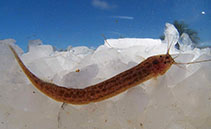| Family: |
Trichomycteridae (Pencil or parasitic catfishes), subfamily: Trichomycterinae |
| Max. size: |
4.86 cm SL (male/unsexed) |
| Environment: |
benthopelagic; freshwater |
| Distribution: |
South America: known only from rio Palmares, a tributary of the rio Cahy in Bahia, Brazil. |
| Diagnosis: |
Dorsal spines (total): 0-0; Dorsal soft rays (total): 9-9; Anal soft rays: 7-8; Vertebrae: 40-40. Distinguished from most of its congeners, except Ituglanis macunaima and Ituglanis parahybae, by having a pectoral fin ray count of I,4. Differs also from all its congeners, excluding Ituglanis parahybae, by the coloration pattern with longitudinal rows of coalescing blotches. Can be differentiated from Ituglanis parahybae by the supraorbital laterosensory canal branch with pores s3 and s6 present.
Description: Dorsal fin ii,7; Anal fin ii,5-6; Pectoral fin i,4; Pelvic fin i,3 (Ref. 57703). |
| Biology: |
Found in brown waters with moderate flowing current and sandy or gravel bottom. Feeds on insect larvae, nymphs and organic matter (Ref. 57703). |
| IUCN Red List Status: |
Near Threatened (NT); Date assessed: 16 May 2022 (B1b(iii,v)) Ref. (130435)
|
| Threat to humans: |
harmless |
Source and more info: www.fishbase.org. For personal, classroom, and other internal use only. Not for publication.

